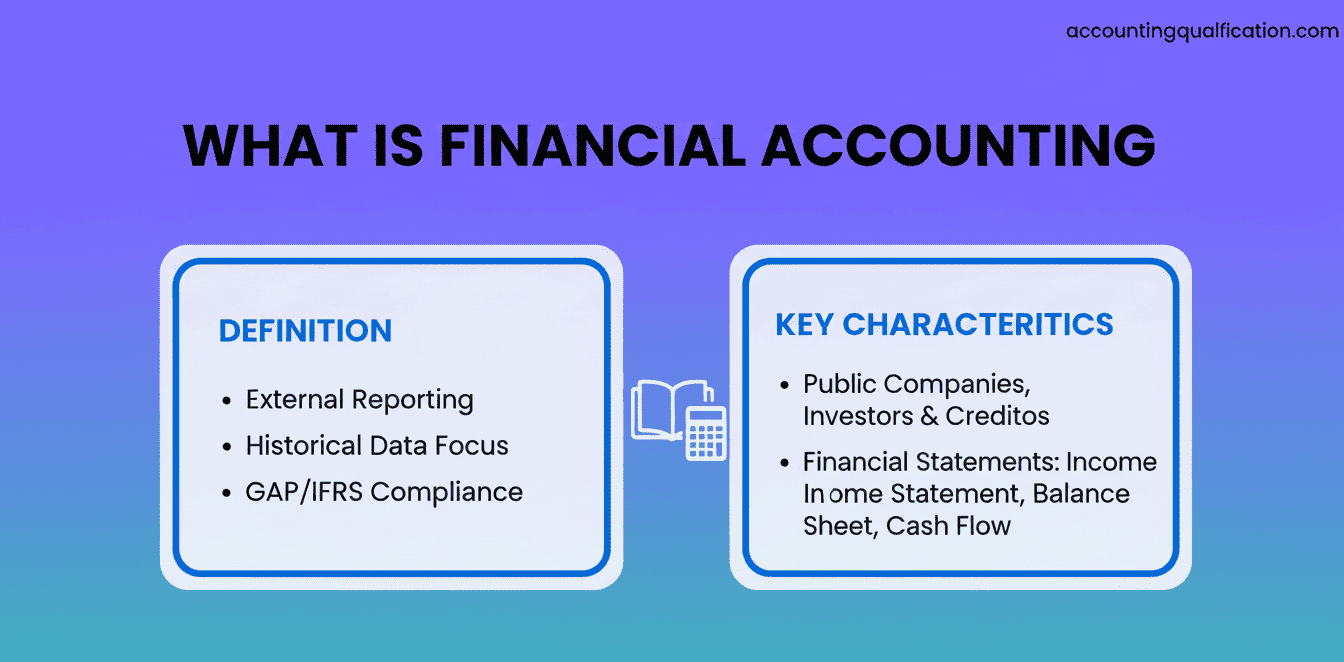Introduction to Financial Accounting
If you’ve ever read a company’s annual report or heard investors talk about profit and loss, you’ve seen financial accounting in action. It’s the part of accounting that tells the story of a business’s financial health—clear enough for outsiders like investors, regulators, and lenders to understand.
Financial accounting is often called the “universal language of business” because it provides standardised information that can be compared across companies, industries, and even countries. Whether it’s a small family shop or a global corporation, financial accounting plays the same critical role: showing how money flows in, how it’s spent, and what’s left over.
What is Financial Accounting?
Financial accounting is the process of recording, summarising, and reporting an organisation’s financial transactions. Its main purpose is to create financial statements that reflect the business’s performance and position over a specific period.
The key outputs of financial accounting are:
- Balance Sheet – A snapshot of assets, liabilities, and equity at a given date.
- Income Statement (Profit & Loss) – A report of revenues, expenses, and net profit or loss.
- Cash Flow Statement – Tracks how money moves in and out of the business.
- Statement of Changes in Equity – Shows changes in ownership value.
These reports aren’t just for managers—they’re designed for external audiences such as investors, regulators, tax authorities, and lenders.
Principles of Financial Accounting
Financial accounting follows a set of established rules and standards to ensure consistency and trustworthiness. These are often referred to as Generally Accepted Accounting Principles (GAAP) or International Financial Reporting Standards (IFRS), depending on the country.
Some of the core principles include:
- Accrual Principle – Transactions are recorded when they occur, not just when cash changes hands.
- Consistency Principle – Companies must use the same accounting methods over time for comparability.
- Going Concern Principle – Assumes the business will continue operating into the foreseeable future.
- Prudence Principle – Accountants should not overstate income or assets; caution is key.
- Materiality Principle – Financial reports should focus on information that matters to decision-making.
- Faithful Representation – Information must be complete, neutral, and free from bias.
Why Financial Accounting Matters
Financial accounting isn’t just about compliance—it’s the backbone of trust and decision-making in the financial world. Here’s why it matters:
- For Investors: Helps them assess whether to buy, hold, or sell shares.
- For Lenders: Provides insight into a company’s ability to repay loans.
- For Regulators: Ensures businesses meet legal and reporting requirements.
- For Management: Offers an external benchmark of how the business is performing.
In fact, global stock markets rely heavily on transparent financial reporting. Without it, confidence in investments and corporate governance would collapse.
Key Financial Statements Explained
Financial accounting revolves around four main statements. Together, they provide a complete picture of an organisation’s performance and position.
1. Balance Sheet
The balance sheet is like a financial snapshot, showing what a business owns (assets), what it owes (liabilities), and the residual interest left for owners (equity).
👉 Example: A tech start-up may list computers, patents, and cash as assets; loans and unpaid bills as liabilities; and the founders’ investment as equity.
2. Income Statement (Profit & Loss)
This statement reveals how much money came in (revenue), how much went out (expenses), and what’s left as profit or loss. It answers the big question: is the business making money?
👉 Example: A coffee shop might report £100,000 in sales, £70,000 in costs (ingredients, rent, wages), leaving £30,000 profit.
3. Cash Flow Statement
Profit doesn’t always equal cash in hand. The cash flow statement tracks money moving in and out, separating it into:
- Operating activities (day-to-day trade)
- Investing activities (buying equipment, property)
- Financing activities (loans, dividends, share issues)
👉 Example: A profitable company could still face a cash crunch if too much money is tied up in unpaid invoices.
4. Statement of Changes in Equity
This less-talked-about statement shows how ownership value changes over time—through profits, losses, investments, or dividends. It explains shifts in shareholders’ stake in the business.
Examples of Financial Accounting in Action
Publicly Traded Companies
Listed companies are legally required to publish audited financial statements, usually quarterly or annually. For example, when Apple or Toyota releases their earnings reports, investors and analysts pore over them to gauge performance.
Small and Medium Enterprises (SMEs)
Even small businesses use financial accounting for tax compliance, securing loans, and attracting investors. Banks often require accurate financial statements before granting credit.
Non-Profits and Charities
Though not profit-driven, charities must show donors and regulators how funds are used. Transparency builds trust and encourages continued support.
Conclusion
Financial accounting is the backbone of modern business. It records the story of money, creates transparency, and provides the insights that drive smarter decisions. From small enterprises to global corporations, financial accounting ensures that numbers aren’t just recorded—they’re understood.
As technology reshapes the profession, financial accounting will only grow in importance. Accountants will increasingly serve as trusted advisors, guiding businesses, governments, and individuals through complex financial landscapes.
So, whether you’re a student considering a career, an entrepreneur managing a start-up, or an investor reading a company report—remember this: financial accounting isn’t just about numbers, it’s about making those numbers meaningful.
What is financial accounting in simple terms?
Financial accounting is the process of recording and reporting a company’s financial activities through statements like balance sheets, income statements, and cash flow reports.
What is the main purpose of financial accounting?
Its purpose is to provide reliable information to external stakeholders—such as investors, regulators, and lenders—so they can assess a business’s performance and financial health.
What are the key financial statements?
The four main statements are:
Balance Sheet
Income Statement (Profit & Loss)
Cash Flow Statement
Statement of Changes in Equity
How is financial accounting different from management accounting?
Financial accounting focuses on external reporting, while management accounting provides internal insights for decision-making, budgeting, and strategy.
